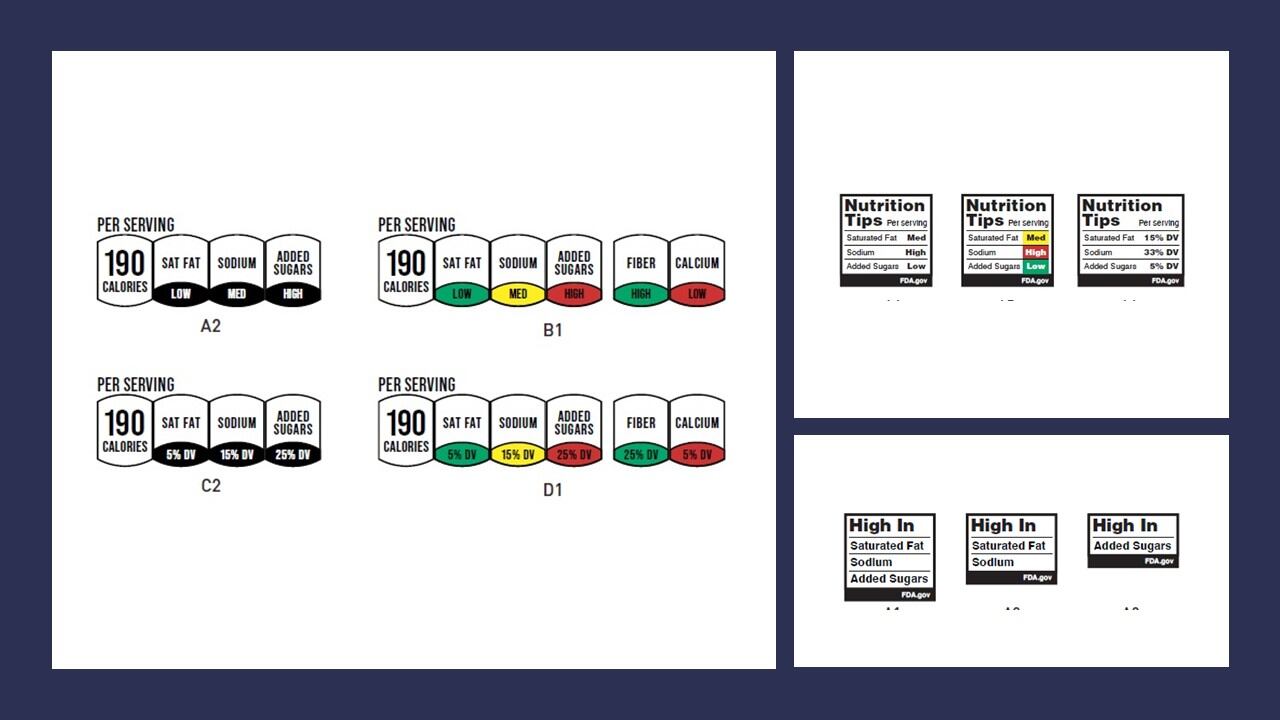“The United States continues to face an epidemic of diet-related chronic diseases, many of which are experienced disproportionately by racial and ethnic minority groups, those with lower socioeconomic status and those living in rural areas. To help address this problem … we are exploring the establishment of a standardized, science-based FOP scheme that helps consumers, particularly those with lower nutrition literacy, quickly and easily identify foods that are part of a healthy eating pattern,” the agency said in a Federal Register notice published last week.
Building on a literature review and focus group tests of FOP concepts conducted last year, FDA plans to gather 3,000 consumers responses to several science-based designs that fall into three general groups.
FDA to test consumer understanding of different designs
The first include black-and-white and green-yellow-red designs similar to the existing Facts Up Front system created by FMI – The Industry Trade Group and the Grocery Manufacturers Association (now the Consumer Brands Association) in the fall of 2011, which earned limited support from FDA at the time and biting criticism from the Center for Science in the Public Interest.
Like the Facts Up Front scheme, which was on upwards of 90% of packaged foods within years of rolling out, FDA’s first proposed design includes an icon that highlights calories per serving and whether there are low, medium or high amounts of saturated fat, sodium, added sugars, fiber and calcium. FDA also is exploring versions that call out the daily value amount of each nutrient and color-coded versions with high in red, medium in yellow and low in green.
The second group of images are small boxes reminiscent of the Nutrition Facts boxes on the back panel, but those on the front panel will be called Nutrition Tips and once again characterize the amounts of saturated fat, sodium, added sugar, fiber and calcium as low, medium or high with some versions including stoplight color coding and the percent daily value of each per serving.
The final group also mimics the look of the Nutrition Facts panel but simply says High In and then lists the nutrients of concern (saturated fat, sodium and added sugar) with some versions also including the percent of daily value per serving.
FDA’s study follows call by White House for FOP scheme
FDA’s announcement comes months after the Biden Administration released a 44-page strategy document to reduce the intake of added sugar and other nutrients of concern ahead of the White House Conference on Hunger, Nutrition and Health. In it, the administration called on FDA to explore FOP labeling schemes with an eye towards developing standardized system for packaged food to help consumers identify foods that are part of a healthy eating pattern.
FDA also notes its current review comes after “increased attention in recent years … and the experience of countries that have adopted FOP labeling … that suggests that FOP labeling may aid nutrition comprehension and the ability to make healthier choices.”
Analysis of the voluntary Facts Up Front scheme also found the labeling was associated with improved nutritional quality, and could be an effective tool for encouraging change on an industry level.
This not the first time that FDA has considered FOP labeling. In 2010, the agency called for industry comments on FOP labeling following public outrage about what many saw as abuse of the FOP Smart Choices labeling program.
Then, like now, FDA noted FOP labeling could help consumers make healthier choices, but unlike then when FDA put forth the idea as voluntary, this time the agency is considering making the labeling mandatory – which would close a loophole in which less healthy foods avoid FOP labels that could discourage sales.
FOP labeling triggers mixed emotions
While industry supports the voluntary Facts Up Front labeling scheme, CBA’s Sarah Gallo, vice president of product policy, told FoodNavigator-USA when the White Houe floated the idea of mandatory scheme that it could inadvertently hurt consumers, but that it supports voluntary FOP labeling.
CSPI, however, said it was ‘thrilled’ by the idea and reiterated its call for a front-of-pack labeling system that was scientifically-based, mandatory and standardized, which it also called for in a Citizen Petition filed with FDA last summer.
Other stakeholders have expressed concern that traffic light color-coding could discourage consumers from looking at the Nutrition Facts panel or from considering how each food fits into their overall diet.
Recognizing the diversity of views held by stakeholders, FDA is soliciting comments about the upcoming research project through March. 27


